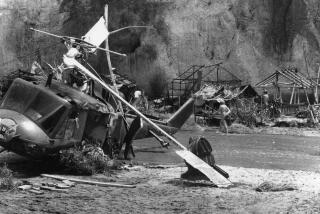Last Effects : OUTRAGEOUS CONDUCT Art, Ego and the Twilight Zone Case<i> by Stephen Farber and Marc Green (Arbor House/ William Morrow: $18.95; 383 pp., illustrated) </i>
- Share via
The eye-catching interplay between reality and illusion has been a staple of film making since the days of the silent screen, when startled spectators occasionally bolted from their seats at the sight of oncoming trains.
Regrettably, death, that grimmest of realities, has interceded all too often as directors film their illusions.
Over the years, no cinema tragedy has been more highly publicized--and many would argue, more easily avoidable--than the 1982 helicopter crash on the set of “Twilight Zone: The Movie,” a feature dealing with, ironically enough, the gray area between reality and illusion.
“Outrageous Conduct” chronicles the events leading to the horrific accident in which actor Vic Morrow and two young Vietnamese immigrant children were killed during the shooting of a Vietnam War battle sequence. It also analyzes the stormy 10-month manslaughter trial of director John Landis and four associates, which ended in their total acquittal by a Los Angeles County jury last year.
In their well-paced, workmanlike account, Stephen Farber and Marc Green put together a stronger case than did Deputy Dist. Atty. Lea Purwin D’Agostino--against both Landis and Hollywood in general.
The co-authors contend that the film community, fueled by excessive ego and a blind focus on money-making, has created an atmosphere in which film sets have become tragedies waiting to happen.
“In the 1970s, the studios abdicated power,” write the pair, who previously teamed on another nonfiction work, “Hollywood Dynasties.” “They granted not just final cut but complete control to any director who scored at the box office.”
Such directors, the writers add, are oft-times immature and inexperienced, yet used to getting their way--and their camera angles--regardless of the potential danger.
None more so, they say, than Landis, a brash high school dropout from West Los Angeles whose tempestuous personality had but one outlet: making movies.
Falling in love with film as a youngster--he claims he was inspired by viewing “The Seventh Voyage of Sinbad” at age 8--Landis obsessively followed his dream, progressing from a job in the 20th Century-Fox mailroom and as a stunt double in Spain to the post of director on “Animal House” at age 28.
With the dizzying success of his anarchic comedy, Landis received carte blanche on “The Blues Brothers,” and proceeded to go special-effects-crazy, dropping a car from a helicopter, destroying a shopping mall and, in one scene, wrecking 60 police vehicles, all in the name of humor.
Then came “Twilight Zone,” a co-production with fellow Wunderkind Steven Spielberg, whom the authors soundly criticize for distancing himself from the tragedy in order to protect “Sir Spielberg’s” (as they call him) image.
In filming the fateful scene, Landis did not have to put three actors near a low-flying, three-ton helicopter as special-effects explosives were fired into the sky--he could have achieved a similiar, if less spectacular, effect through creative editing.
Yet was it manslaughter?
If “Outrageous Conduct” has a major flaw, it is a failure to come to grips with why, despite the stupidity of his actions, Landis was found not guilty in court. The authors, who sat through the contentious trial, never adequately convey the carnival-like courtroom atmosphere or the vainglorious D’Agostino’s strategic blunders, including a propensity to over-rely on witnesses whose testimony sometimes seemed less than 100% reliable.
Not that it was a clear-cut case of homicide anyway. After all, if the scene was unequivocally dangerous, why did Landis position himself in the vicinity of the helicopter and why were two of his co-defendants actually in the chopper when it crashed? Certainly they weren’t suicidal.
Still, Farber and Green make many telling points and are at their strongest when quoting other directors who describe their own harrowingly close calls. Indeed, the authors appear to go a long way toward explaining Landis’ actions by revealing the mindset of fellow movie makers.
“It’s so easy to forget that you’re dealing with big machines that really hurt people,” they are told by John Badham, director of “Blue Thunder.” “You get so involved in the make-believe that sometimes you ignore the grim realities.”
More to Read
Only good movies
Get the Indie Focus newsletter, Mark Olsen's weekly guide to the world of cinema.
You may occasionally receive promotional content from the Los Angeles Times.










